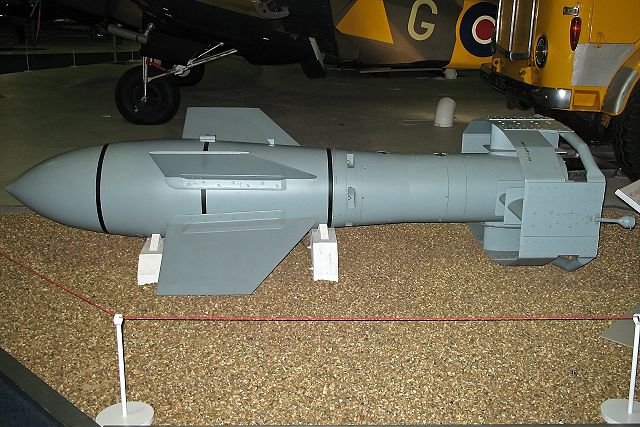The Henschel Hs 293 was a World War II German radio-guided glide bomb. It is the first operational anti-shipping missile, first used unsuccessfully on 25 August 1943 and then with increasing success over the next year, ultimately damaging or sinking at least 25 ships. Allied efforts to jam the radio control link were increasingly successful despite German efforts to counter them. The weapon remained in use through 1944 when it was also used as an air-to-ground weapon to attack bridges to prevent the Allied breakout after D-Day, but proved almost useless in this role.
Hs 293 on display at the Deutsches Technikmuseum in Berlin, Germany, with added "Kopfring" (lit. "head ring") on the nose for nautical targets
A schematic drawing of a Hs 293
The Walter 109-507 rocket motor unit with propellant tanks, removed from its nacelle under the Hs 293.
An Hs 293 A-1 on display at the Udvar-Hazy Center.
A glide bomb or stand-off bomb is a standoff weapon with flight control surfaces to give it a flatter, gliding flight path than that of a conventional bomb without such surfaces. This allows it to be released at a distance from the target rather than right over it, allowing a successful attack without exposing the launching aircraft to anti-aircraft defenses near the target. Glide bombs can accurately deliver warheads in a manner comparable to cruise missiles at a fraction of the cost—sometimes by installing flight control kits on simple unguided bombs—and they are very difficult for surface-to-air missiles to intercept due to their tiny radar signatures and short flight times. The only effective countermeasure in most cases is to shoot down enemy aircraft before they approach within launching range, making glide bombs very potent weapons where wartime exigencies prevent this.
A German 'Fritz X' glide bomb
An F-16C releases an AGM-154 JSOW. The AGM-154 JSOW has a range of 12 nmi (22 km) for a low altitude launch, or 70 nmi (130 km) for a high altitude launch.
HOPE/HOSBO of the Luftwaffe







